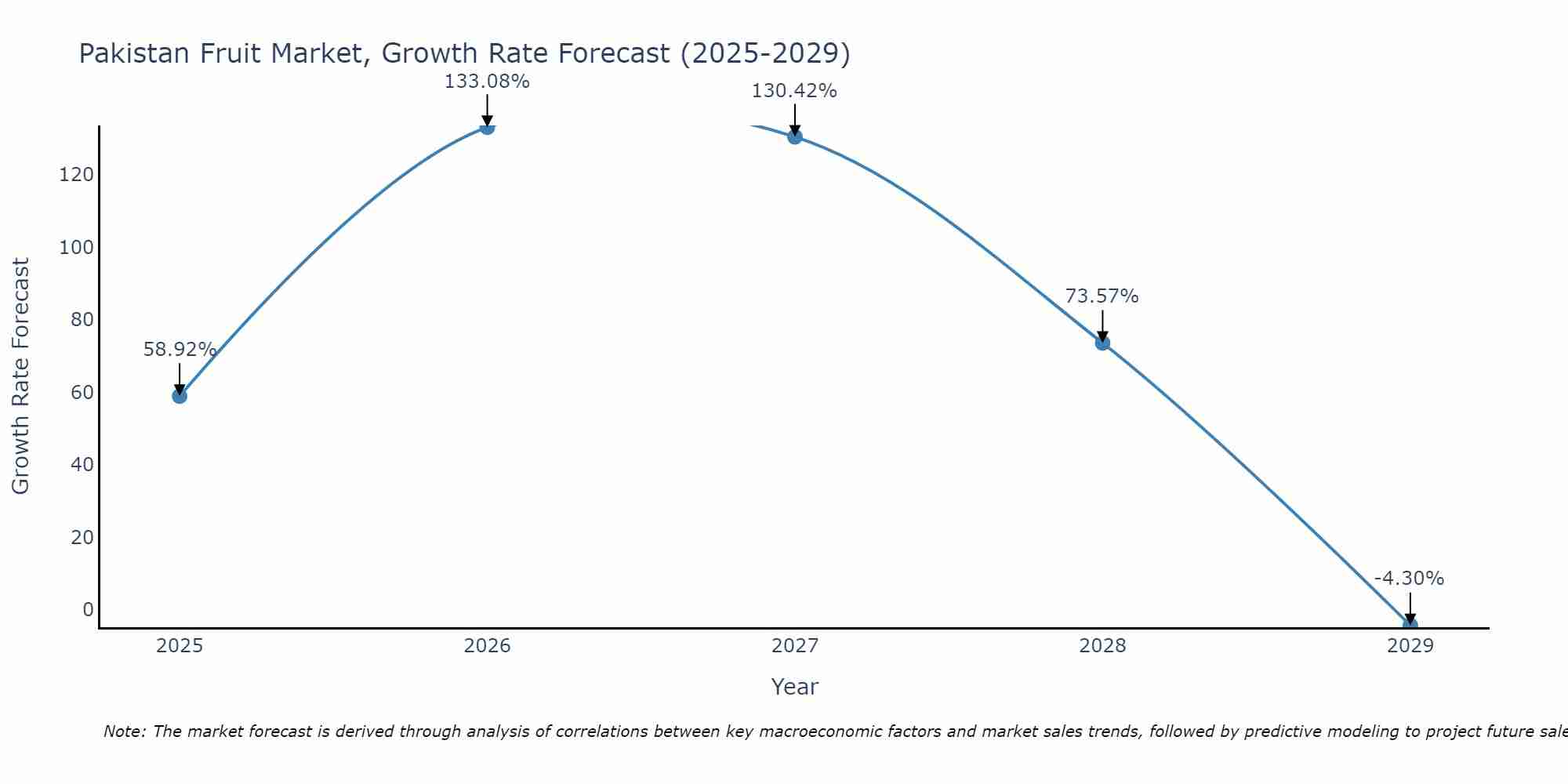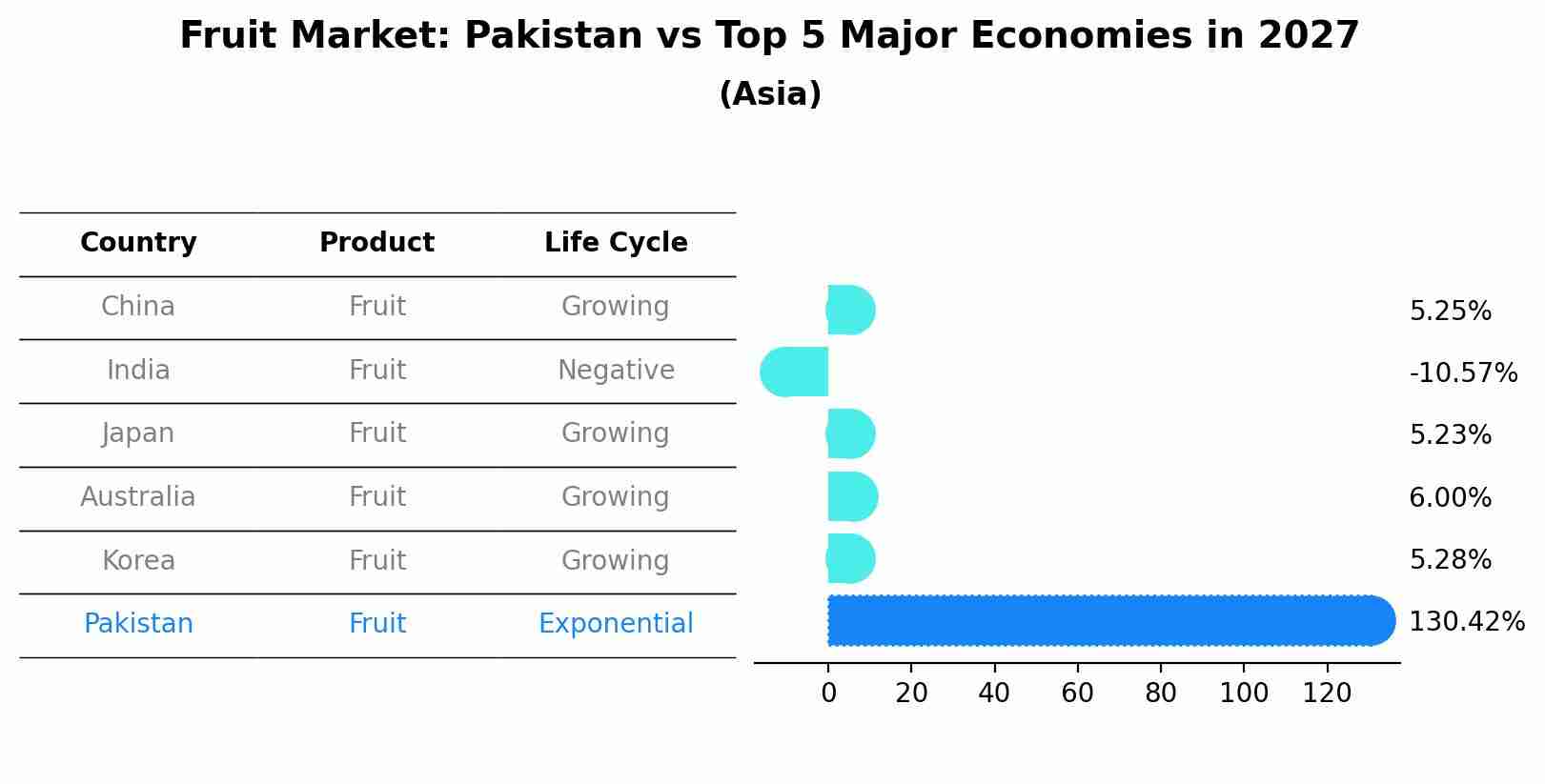Pakistan Fruit Market (2025-2031) | Industry, Forecast, Revenue, Share, Size, Value, Outlook, Trends, Analysis, Growth & Companies
| Product Code: ETC020037 | Publication Date: Oct 2020 | Updated Date: Jun 2025 | Product Type: Report | |
| Publisher: 6Wresearch | Author: Bhawna Singh | No. of Pages: 70 | No. of Figures: 35 | No. of Tables: 5 |
Pakistan Fruit Market Size Growth Rate
The Pakistan Fruit Market is projected to witness mixed growth rate patterns during 2025 to 2029. Growth accelerates to 133.08% in 2026, following an initial rate of 58.92%, before easing to -4.30% at the end of the period.

Fruit Market: Pakistan vs Top 5 Major Economies in 2027 (Asia)
In the Asia region, the Fruit market in Pakistan is projected to expand at a exponential growth rate of 130.42% by 2027. The largest economy is China, followed by India, Japan, Australia and South Korea.

Pakistan Fruit Market Overview
The Pakistan fruit market is a vibrant and diverse sector that offers a wide variety of fresh fruits to consumers. The market is characterized by a mix of traditional fruits such as mangoes, oranges, and bananas, as well as exotic fruits like lychee, guava, and pomegranate. Pakistan is known for its high-quality fruits, particularly mangoes, which are sought after both domestically and internationally. The market is fragmented, with a mix of small-scale farmers and larger commercial producers contributing to the supply chain. Urban areas have a thriving fruit market with numerous vendors selling fresh produce on street corners and in markets. Overall, the Pakistan fruit market presents opportunities for growth and expansion, driven by increasing demand for healthy and exotic fruits.
Pakistan Fruit Market Trends
Currently, in the Pakistan Fruit Market, there is a growing demand for organic and locally sourced fruits due to increasing health consciousness among consumers. Additionally, there is a trend towards exotic and premium fruits such as avocados, berries, and dragon fruit, driven by a rise in disposable income and a desire for new and unique flavors. Convenience and ready-to-eat fruit options are also gaining popularity as busy lifestyles prompt consumers to seek convenient snacking solutions. Online fruit delivery services are on the rise, offering a convenient way for consumers to access a wide variety of fruits from the comfort of their homes. Overall, the Pakistan Fruit Market is evolving to meet the changing preferences and lifestyles of consumers, with a focus on quality, variety, and convenience.
Pakistan Fruit Market Challenges
In the Pakistan fruit market, several challenges are faced that impact both producers and consumers. Poor infrastructure and logistics lead to high post-harvest losses, affecting the overall supply chain efficiency. Inconsistent quality standards and lack of proper storage facilities further contribute to wastage and reduced market competitiveness. Additionally, limited access to credit and financing options hinders the ability of small-scale farmers to invest in modern farming practices and technologies, affecting their productivity and profitability. Unpredictable weather patterns and natural disasters also pose a significant risk to fruit crops, leading to fluctuating prices and supply shortages. Overall, addressing these challenges through improved infrastructure, quality control measures, financial support, and climate-resilient farming practices is crucial for sustaining the growth of the Pakistan fruit market.
Pakistan Fruit Market Investment Opportunities
The Pakistan fruit market offers various investment opportunities for individuals looking to capitalize on the growing demand for fresh produce. Investors can consider investing in fruit farming, particularly in high-demand fruits such as mangoes, citrus fruits, and guavas. Additionally, establishing cold storage facilities and transportation services to ensure the efficient distribution of fruits can be a profitable venture. Furthermore, investing in fruit processing and packaging units to cater to the increasing trend of packaged and value-added fruit products can also be a lucrative opportunity. With a large domestic market and export potential, the Pakistan fruit market presents diverse investment avenues for those interested in the agriculture and food industry.
Pakistan Fruit Market Government Policy
Government policies related to the Pakistan Fruit Market include regulations on imports and exports, quality standards, and subsidies for farmers. The government has implemented measures to ensure the safety and quality of fruits being traded, such as setting maximum residue limits for pesticides. Additionally, there are initiatives to promote sustainable farming practices and increase productivity through training and research programs. Import and export policies aim to facilitate trade while also protecting local farmers from unfair competition. The government provides subsidies for farmers to support crop production, storage facilities, and transportation infrastructure. Overall, the policies are geared towards fostering a competitive and sustainable fruit market in Pakistan while safeguarding the interests of both producers and consumers.
Pakistan Fruit Market Future Outlook
The future outlook for the Pakistan fruit market appears promising, driven by factors such as increasing urbanization, rising disposable incomes, and growing health consciousness among consumers. With a large population base and a rich agricultural heritage, Pakistan has the potential to expand its fruit market both domestically and internationally. The government`s focus on agricultural development and initiatives to improve infrastructure and logistics will further support the growth of the sector. Additionally, advancements in technology and innovative farming practices are expected to enhance productivity and quality of fruits, boosting competitiveness in the global market. Overall, the Pakistan fruit market is poised for steady growth in the coming years, presenting opportunities for stakeholders across the value chain to capitalize on the evolving consumer preferences and market dynamics.
Key Highlights of the Report:
- Pakistan Fruit Market Outlook
- Market Size of Pakistan Fruit Market, 2024
- Forecast of Pakistan Fruit Market, 2026
- Historical Data and Forecast of Pakistan Fruit Revenues & Volume for the Period 2021 - 2031
- Pakistan Fruit Market Trend Evolution
- Pakistan Fruit Market Drivers and Challenges
- Pakistan Fruit Price Trends
- Pakistan Fruit Porter's Five Forces
- Pakistan Fruit Industry Life Cycle
- Historical Data and Forecast of Pakistan Fruit Market Revenues & Volume By Applications for the Period 2021 - 2031
- Historical Data and Forecast of Pakistan Fruit Market Revenues & Volume By Supermarkets and Hypermarkets for the Period 2021 - 2031
- Historical Data and Forecast of Pakistan Fruit Market Revenues & Volume By Specialty Stores for the Period 2021 - 2031
- Historical Data and Forecast of Pakistan Fruit Market Revenues & Volume By Online for the Period 2021 - 2031
- Historical Data and Forecast of Pakistan Fruit Market Revenues & Volume By Type for the Period 2021 - 2031
- Historical Data and Forecast of Pakistan Fruit Market Revenues & Volume By Fresh for the Period 2021 - 2031
- Historical Data and Forecast of Pakistan Fruit Market Revenues & Volume By Dried for the Period 2021 - 2031
- Historical Data and Forecast of Pakistan Fruit Market Revenues & Volume By Frozen for the Period 2021 - 2031
- Historical Data and Forecast of Pakistan Fruit Market Revenues & Volume By Others for the Period 2021 - 2031
- Pakistan Fruit Import Export Trade Statistics
- Market Opportunity Assessment By Applications
- Market Opportunity Assessment By Type
- Pakistan Fruit Top Companies Market Share
- Pakistan Fruit Competitive Benchmarking By Technical and Operational Parameters
- Pakistan Fruit Company Profiles
- Pakistan Fruit Key Strategic Recommendations
Frequently Asked Questions About the Market Study (FAQs):
1 Executive Summary |
2 Introduction |
2.1 Key Highlights of the Report |
2.2 Report Description |
2.3 Market Scope & Segmentation |
2.4 Research Methodology |
2.5 Assumptions |
3 Pakistan Fruit Market Overview |
3.1 Pakistan Country Macro Economic Indicators |
3.2 Pakistan Fruit Market Revenues & Volume, 2019 & 2026F |
3.3 Pakistan Fruit Market - Industry Life Cycle |
3.4 Pakistan Fruit Market - Porter's Five Forces |
3.5 Pakistan Fruit Market Revenues & Volume Share, By Applications, 2019 & 2026F |
3.6 Pakistan Fruit Market Revenues & Volume Share, By Type, 2021 & 2031F |
4 Pakistan Fruit Market Dynamics |
4.1 Impact Analysis |
4.2 Market Drivers |
4.3 Market Restraints |
5 Pakistan Fruit Market Trends |
6 Pakistan Fruit Market, By Types |
6.1 Pakistan Fruit Market, By Applications |
6.1.1 Overview and Analysis |
6.1.2 Pakistan Fruit Market Revenues & Volume, By Applications, 2016 - 2026F |
6.1.3 Pakistan Fruit Market Revenues & Volume, By Supermarkets and Hypermarkets, 2016 - 2026F |
6.1.4 Pakistan Fruit Market Revenues & Volume, By Specialty Stores, 2016 - 2026F |
6.1.5 Pakistan Fruit Market Revenues & Volume, By Online, 2016 - 2026F |
6.2 Pakistan Fruit Market, By Type |
6.2.1 Overview and Analysis |
6.2.2 Pakistan Fruit Market Revenues & Volume, By Fresh, 2016 - 2026F |
6.2.3 Pakistan Fruit Market Revenues & Volume, By Dried, 2016 - 2026F |
6.2.4 Pakistan Fruit Market Revenues & Volume, By Frozen, 2016 - 2026F |
6.2.5 Pakistan Fruit Market Revenues & Volume, By Others, 2016 - 2026F |
7 Pakistan Fruit Market Import-Export Trade Statistics |
7.1 Pakistan Fruit Market Export to Major Countries |
7.2 Pakistan Fruit Market Imports from Major Countries |
8 Pakistan Fruit Market Key Performance Indicators |
9 Pakistan Fruit Market - Opportunity Assessment |
9.1 Pakistan Fruit Market Opportunity Assessment, By Applications, 2019 & 2026F |
9.2 Pakistan Fruit Market Opportunity Assessment, By Type, 2019 & 2026F |
10 Pakistan Fruit Market - Competitive Landscape |
10.1 Pakistan Fruit Market Revenue Share, By Companies, 2024 |
10.2 Pakistan Fruit Market Competitive Benchmarking, By Operating and Technical Parameters |
11 Company Profiles |
12 Recommendations |
13 Disclaimer |
- Single User License$ 1,995
- Department License$ 2,400
- Site License$ 3,120
- Global License$ 3,795
Search
Thought Leadership and Analyst Meet
Our Clients
Related Reports
- Afghanistan Apparel Market (2026-2032) | Growth, Outlook, Industry, Segmentation, Forecast, Size, Companies, Trends, Value, Share, Analysis & Revenue
- Canada Oil and Gas Market (2026-2032) | Share, Segmentation, Value, Industry, Trends, Forecast, Analysis, Size & Revenue, Growth, Competitive Landscape, Outlook, Companies
- Germany Breakfast Food Market (2026-2032) | Industry, Share, Growth, Size, Companies, Value, Analysis, Revenue, Trends, Forecast & Outlook
- Australia Briquette Market (2025-2031) | Growth, Size, Revenue, Forecast, Analysis, Trends, Value, Share, Industry & Companies
- Vietnam System Integrator Market (2025-2031) | Size, Companies, Analysis, Industry, Value, Forecast, Growth, Trends, Revenue & Share
- ASEAN and Thailand Brain Health Supplements Market (2025-2031) | Strategy, Consumer Insights, Analysis, Investment Trends, Opportunities, Growth, Size, Share, Industry, Revenue, Segments, Value, Segmentation, Supply, Forecast, Restraints, Outlook, Competition, Drivers, Trends, Demand, Pricing Analysis, Competitive, Strategic Insights, Companies, Challenges
- ASEAN Bearings Market (2025-2031) | Strategy, Consumer Insights, Analysis, Investment Trends, Opportunities, Growth, Size, Share, Industry, Revenue, Segments, Value, Segmentation, Supply, Forecast, Restraints, Outlook, Competition, Drivers, Trends, Demand, Pricing Analysis, Competitive, Strategic Insights, Companies, Challenges
- Europe Flooring Market (2025-2031) | Outlook, Share, Industry, Trends, Forecast, Companies, Revenue, Size, Analysis, Growth & Value
- Saudi Arabia Manlift Market (2025-2031) | Outlook, Size, Growth, Trends, Companies, Industry, Revenue, Value, Share, Forecast & Analysis
- Uganda Excavator, Crane, and Wheel Loaders Market (2025-2031) | Strategy, Consumer Insights, Analysis, Investment Trends, Opportunities, Growth, Size, Share, Industry, Revenue, Segments, Value, Segmentation, Supply, Forecast, Restraints, Outlook, Competition, Drivers, Trends, Demand, Pricing Analysis, Competitive, Strategic Insights, Companies, Challenges
Industry Events and Analyst Meet
Whitepaper
- Middle East & Africa Commercial Security Market Click here to view more.
- Middle East & Africa Fire Safety Systems & Equipment Market Click here to view more.
- GCC Drone Market Click here to view more.
- Middle East Lighting Fixture Market Click here to view more.
- GCC Physical & Perimeter Security Market Click here to view more.
6WResearch In News
- Doha a strategic location for EV manufacturing hub: IPA Qatar
- Demand for luxury TVs surging in the GCC, says Samsung
- Empowering Growth: The Thriving Journey of Bangladesh’s Cable Industry
- Demand for luxury TVs surging in the GCC, says Samsung
- Video call with a traditional healer? Once unthinkable, it’s now common in South Africa
- Intelligent Buildings To Smooth GCC’s Path To Net Zero


















